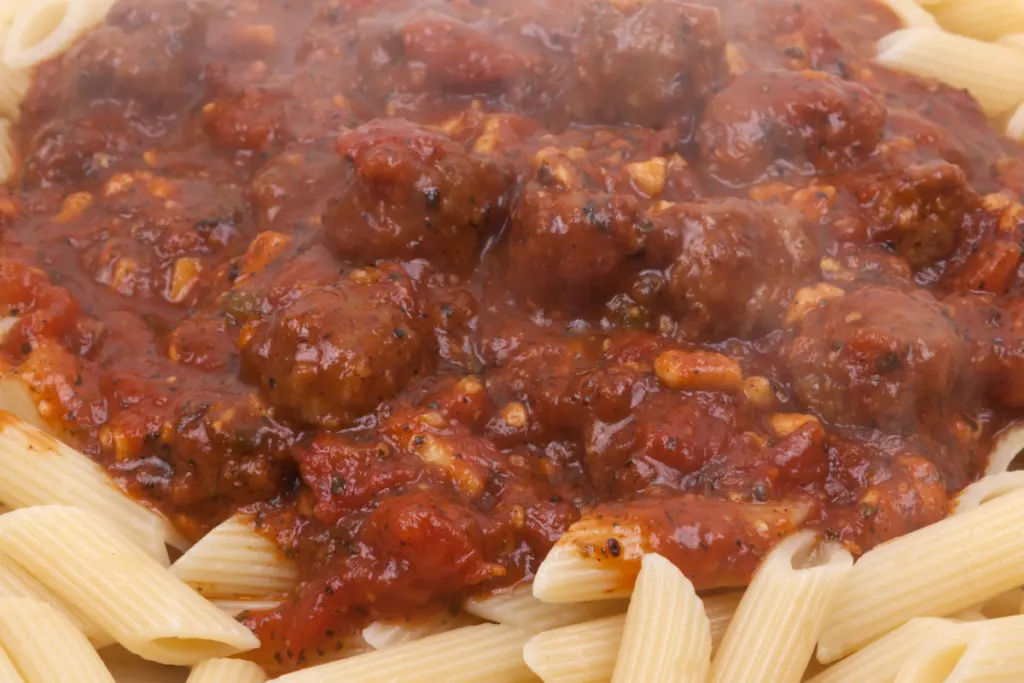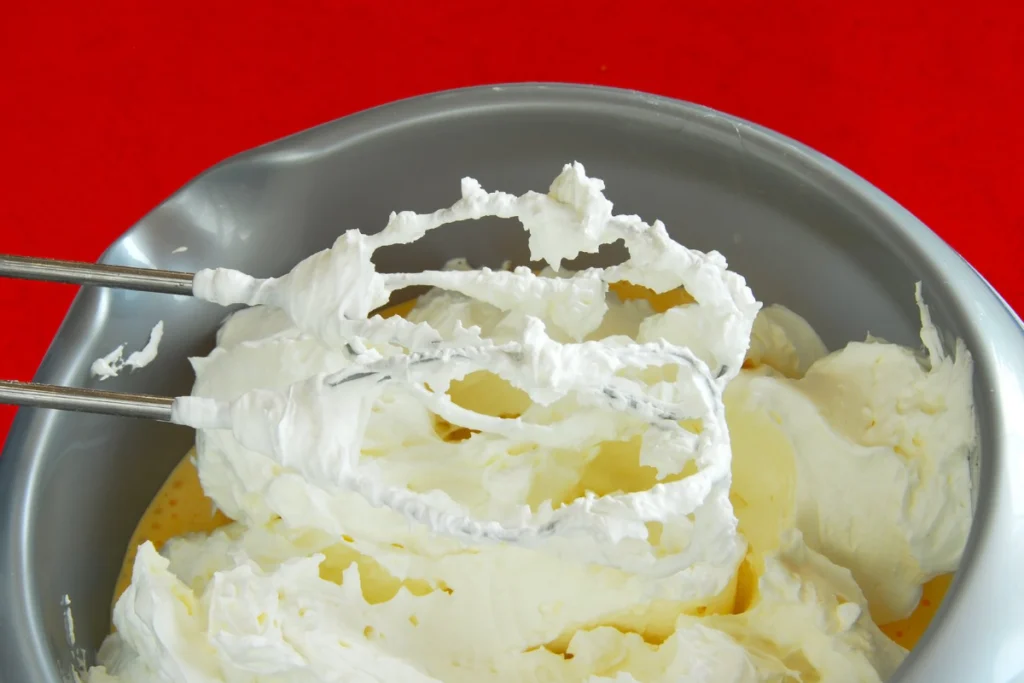A weak and dreary-looking meat sauce dish is the last thing you want to have before preparing a meal for guests. The golden rule in any sauce is to nail the consistency, so if your sauce falls shy of its mark, you’ll need a way to thicken meat sauce. Now, there are several ways to thicken meat sauces, like using cornstarch or flour or reducing the sauce. Here, we’ll discuss everything about these and more so you’ll know the best option on how to thicken your meat sauce.

Jump To
What is Meat Sauce
Meat sauce, often referred to as a Bolognese sauce in Italian cuisine, is a savory sauce primarily made from ground meat (commonly beef or pork), tomatoes, onions, garlic, and herbs. It’s typically simmered for an extended period to allow the flavors to meld, resulting in a rich, thick sauce that pairs well with pasta dishes like spaghetti or lasagna. Variations can include additional ingredients such as wine, carrots, or celery for added depth and complexity.
Why Consider Thickening Meat Sauce?
A watery or runny consistency can drastically affect the taste and make it challenging to pair with pasta or other dishes. So, a thicker meat sauce is definitely the right choice, but why?
Well, for starters, it can make the sauce stick better to your pasta or other food and intensify the flavors of them. This can be especially important if you are using a leaner cut of meat, which may not have as much flavor as a fattier cut. It also just generally feels better in your mouth and makes the overall experience more enjoyable.
Why Is My Meat Sauce Not Thick Enough?
A thick meat sauce would be perfect for delicious dishes like shepherd’s pies, pizzas, and meatball subs. However, knowing the reasons as to why it was runny in the first place will be your best shot at avoiding it next time.
Not Enough Time to Cook
If you don’t cook your meat sauce for long enough, it won’t thicken properly. This is due to the lack of evaporation of the liquid in the sauce. It’s a pretty common mistake to happen, so don’t sweat it. To achieve a thicker texture, just give it enough time to cook and reduce.
Using Too Much Liquid
Adding too much liquid to a meat sauce is probably an obvious reason why it may be runny. This can happen when too much broth, water, or tomato sauce is added to the recipe, but you can either reduce the amount of liquid or increase the amount of meat to counter this. This will give the sauce a more concentrated flavor and a thicker consistency. Another trick is to incorporate a browning sauce, which not only deepens the color but also adds a richer flavor, helping to balance out the consistency.
Not Using a Thickening Agent
Another reason could be that you didn’t use a thickening agent such as flour or cornstarch in the meat sauce. These agents help to bind the liquid in the sauce, creating a thicker consistency. Without a thickening agent, the liquid in the sauce remains thin and watery. So add roux, flour, or cornstarch to the recipe to help create a more satisfying and delicious meat sauce.

Ways to Thicken Meat Sauce
Add Tomato Paste
This is the pastier and more concentrated version of what’s already being used in the sauce, so it’ll be a good choice for thickening your meat sauce. As the tomato paste cooks, it will caramelize and develop a rich flavor while thickening the sauce. This’ll also enhance the taste and make it richer and thicker.
All you have to do is add tomato paste to your meat sauce, brown your meat and vegetables in a pot, and then stir in the tomato paste. Just keep an eye on it, and the cooking process will do the rest.
Simmer and Reduce
Simmering and reducing is a proven and effective cooking technique that’ll whip any runny sauce into shape. This process slowly evaporates the liquid in the sauce, concentrating the flavors and resulting in a thicker sauce. This technique also allows the sauce to thicken naturally as the water content decreases, resulting in a more complex and delicious sauce.
In applying this technique to your meat sauce, let it simmer uncovered until it reaches a thickness you’re happy with. Make sure to stir the sauce occasionally to prevent it from sticking to the bottom of the pot and burning.

Add Starchy Water
You can even add starchy water to meat sauce for a simple and effective hack to thicken the sauce and enhance its flavor. The process involves using the water where your pasta has been cooked, which contains starch, then adding a small amount at a time to your sauce, stirring constantly until it thickens to how you like it. However, don’t add too much of it, as this can make the sauce too thick or gummy.
Add a Cornstarch Slurry
A popular technique used to thicken meat sauce without altering its flavor is a cornstarch slurry. It’s a quick and easy alternative to adding extra flour or other thickeners that can change the flavor of the sauce.
If you want to make this slurry, mix cornstarch with cold water in a small bowl until it forms a smooth, runny paste. Once prepared, add it to the meat sauce a little at a time, stirring constantly to prevent lumps from forming. The slurry works by binding with the liquid in the meat sauce, creating a thicker and more velvety texture.
Add Some Ground Beef
Ground beef is already a great thickening agent that’s present in your meat sauce, so adding more will certainly help. It releases proteins and fats that enhance both texture and flavor when cooked slowly. Begin by browning the beef in olive oil, draining any excess fat, and incorporating it into the sauce while stirring continuously to prevent clumping. Typically, adding around half a pound of ground beef to a large pot of sauce achieves a desired thickness and enriches the flavor.

Add Mashed Potatoes
Mashed potatoes aren’t the first option you’d look for when aiming to thicken a sauce, but it’s a viable option nonetheless. Russet potatoes are the best for mashing because they are high in starch and low in moisture, which makes them perfect for creating a creamy texture.
To use this option, peel and dice potatoes, boil them until they are soft, and then mash them with milk, butter, and seasonings. After, add and stir them in the sauce until you’re happy with its texture.
Add Cheese
Even adding cheese to your sauce is another great way to enrich it with a thick texture and creamy and savory flavor that perfectly compliments the meat. Cheddar cheese is a popular choice, but you can experiment with different types of cheese to find the flavor you like best. Some examples are parmesan cheese, which has a nutty flavor, and mozzarella cheese, with a creamy texture.
To use them in your sauce, start by browning the meat and sautéing the onions and garlic. Then, add one or two cups of grated cheese to the pot and stir until fully melted and combined with the other ingredients. Make sure to simmer the sauce for long enough to allow the cheese to blend with the other ingredients and create a rich and flavorful sauce.
Add Heavy Cream
Another common ingredient for thickening is heavy cream. If you were to use it in your sauce, it’ll quickly thicken and add a rich and deliciously creamy texture. It pairs well with beef, chicken, and pork meat-based sauces but also in tomato-based or cream-based sauces.
Just start by cooking your meat, adding your liquid, and then bring it to a simmer. Once simmering, add your heavy cream to the pan and stir until it is fully incorporated into the sauce and gives you a thick and rich texture.

Use Flour
Flour is a commonly available and straightforward thickening agent, but it contains gluten. When mixed with a liquid, its gluten proteins swell, thickening the mixture. Begin with a small amount to avoid a starchy taste, gradually increasing as needed. To use flour, create a roux by heating equal parts fat and flour in a saucepan until combined. Incorporate this into your sauce, cooking until desired thickness is achieved.
Use Bread
You don’t see this every day anymore with the addition of more modern ingredients, but using bread to thicken your sauce is a traditional technique that involves adding small pieces of bread to the sauce. Bread contains starch, which is released as it cooks in the sauce, helping to thicken the sauce and create a creamy texture.
However, using it can alter the flavor and color of the sauce, as it can add a slightly sweet flavor and a lighter color to the sauce. If you prefer a more traditional meat sauce flavor, you may want to stick with using flour as a thickening agent.
FAQs
How long does meat sauce last in the fridge?
Meat sauce, when stored properly in an airtight container in the refrigerator, can typically last for 3 to 4 days. It’s important to ensure that the sauce is cooled to room temperature before refrigerating it and that it’s stored in a clean container to prevent contamination.
How many calories are in spaghetti with meat sauce?
The number of calories in spaghetti with meat sauce can vary widely based on the specific recipe and portion size. On average, a serving of spaghetti (about 2 ounces dry) contains approximately 200 calories.
What meat goes with vodka sauce?
Popular choices for vodka sauce include grilled or sautéed chicken, shrimp for seafood lovers, and either mild or spicy Italian sausage. Meatballs can be a classic addition. When selecting a meat, aim to complement the sauce’s creamy, tangy, and slightly spicy flavors for a harmonious dish.
